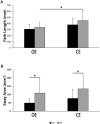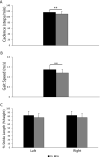Posture and gait in the early course of schizophrenia
- PMID: 33465166
- PMCID: PMC7815098
- DOI: 10.1371/journal.pone.0245661
Posture and gait in the early course of schizophrenia
Abstract
While correlations between postural stability deficits and schizophrenia are well documented, information on dynamic motor alterations in schizophrenia are still scarce, and no data on their onset are available yet. Therefore, the aim of this study was i) to measure gait pattern(s) in patients with schizophrenia; ii) to identify posture and gait alterations which could potentially be used as a predictive clinical tool of the onset of the disorder. Body composition, posture and gait parameters were assessed in a group of 30 patients with schizophrenia and compared to 25 healthy subjects. Sway area was significantly higher in the schizophrenia group compared to controls regardless of whether the participants were in eyes open or eyes closed condition. Gait cadence and speed were significantly lower in patients with schizophrenia, while stride length was similar. We concluded that the combination of an increased sway area (independent from eye closure) and a gait cadence reduction-in the presence of normal gait speed and stride length-might be considered peculiar postural and gait profile characteristic of early schizophrenia.
Conflict of interest statement
The authors have no conflict of interest to declare.
Figures




Similar articles
-
Motor deficits in schizophrenia quantified by nonlinear analysis of postural sway.PLoS One. 2012;7(8):e41808. doi: 10.1371/journal.pone.0041808. Epub 2012 Aug 1. PLoS One. 2012. PMID: 22870250 Free PMC article. Clinical Trial.
-
Posture, gait and self-disorders: An empirical study in individuals with schizophrenia.Early Interv Psychiatry. 2023 May;17(5):447-461. doi: 10.1111/eip.13340. Epub 2022 Aug 6. Early Interv Psychiatry. 2023. PMID: 37156494
-
Trunk sway measures of postural stability during clinical balance tests: effects of a unilateral vestibular deficit.Gait Posture. 2001 Dec;14(3):227-37. doi: 10.1016/s0966-6362(01)00132-1. Gait Posture. 2001. PMID: 11600326
-
A quantitative measure of postural sway deficits in schizophrenia.Schizophr Res. 2004 Jun 1;68(2-3):363-72. doi: 10.1016/j.schres.2003.09.003. Schizophr Res. 2004. PMID: 15099618
-
[Gait disorders in Parkinson disease. Clinical description, analysis of posture, initiation of stabilized gait].Presse Med. 2001 Mar 10;30(9):452-9. Presse Med. 2001. PMID: 11285785 Review. French.
Cited by
-
Quantification of motor abnormalities with instrumental tasks among adolescents with first-episode schizophrenia and depressive disorders.Sci Rep. 2025 Jul 1;15(1):22151. doi: 10.1038/s41598-025-06590-w. Sci Rep. 2025. PMID: 40594440 Free PMC article.
-
Psychomotor slowing alters gait velocity, cadence, and stride length and indicates negative symptom severity in psychosis.Schizophrenia (Heidelb). 2022 Dec 30;8(1):116. doi: 10.1038/s41537-022-00324-x. Schizophrenia (Heidelb). 2022. PMID: 36585399 Free PMC article.
-
The Behavioral Mapping of Psychomotor Slowing in Psychosis Demonstrates Heterogeneity Among Patients Suggesting Distinct Pathobiology.Schizophr Bull. 2023 Mar 15;49(2):507-517. doi: 10.1093/schbul/sbac170. Schizophr Bull. 2023. PMID: 36413085 Free PMC article.
-
Forward head posture associated with reduced cardiorespiratory fitness in psychotic disorders compared to autism spectrum disorder and healthy controls.Sci Rep. 2024 Jul 26;14(1):17143. doi: 10.1038/s41598-024-67604-7. Sci Rep. 2024. PMID: 39060286 Free PMC article.
-
Gait Alterations in the Prediction of Metabolic Syndrome in Patients With Schizophrenia: A Pilot Study With PODOSmart ® Insoles.Front Psychiatry. 2022 Jan 27;13:756600. doi: 10.3389/fpsyt.2022.756600. eCollection 2022. Front Psychiatry. 2022. PMID: 35153872 Free PMC article.
References
Publication types
MeSH terms
LinkOut - more resources
Full Text Sources
Other Literature Sources
Medical

